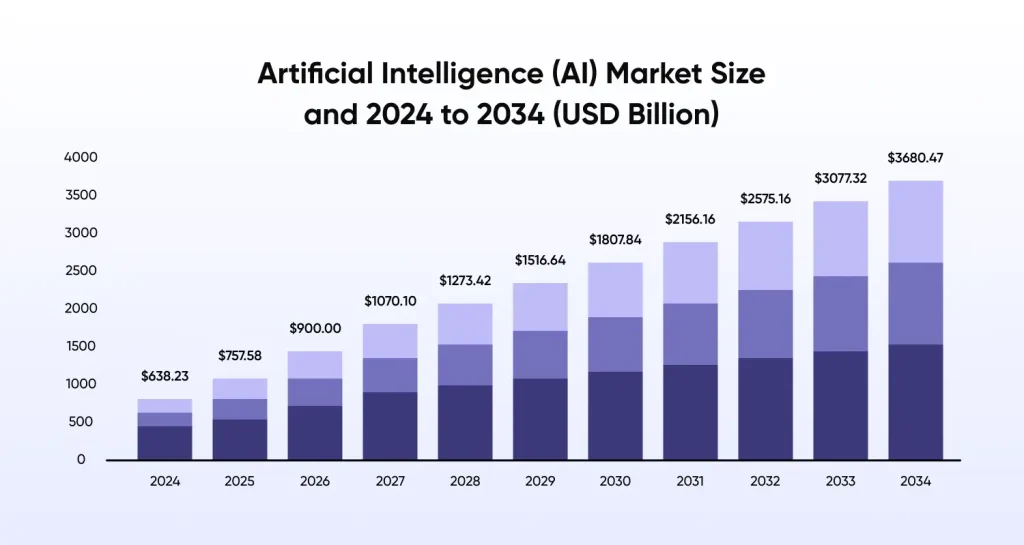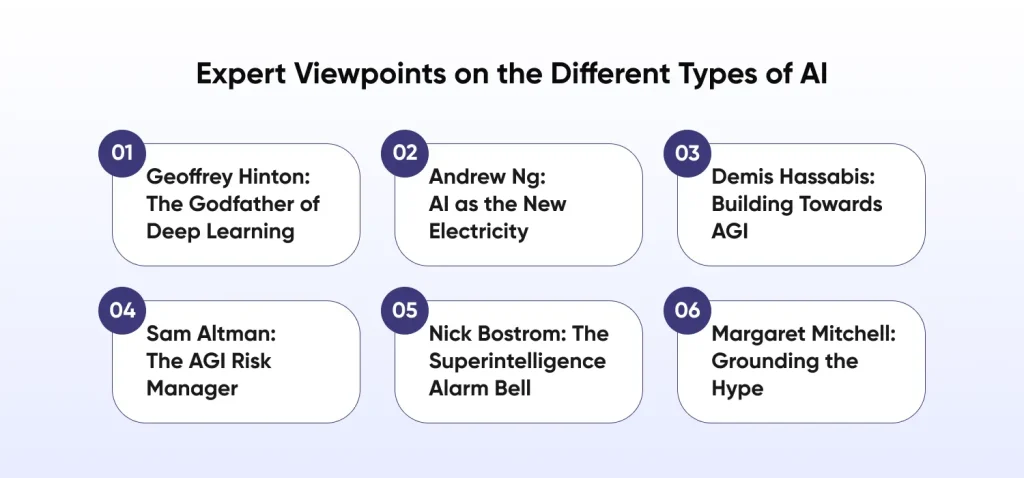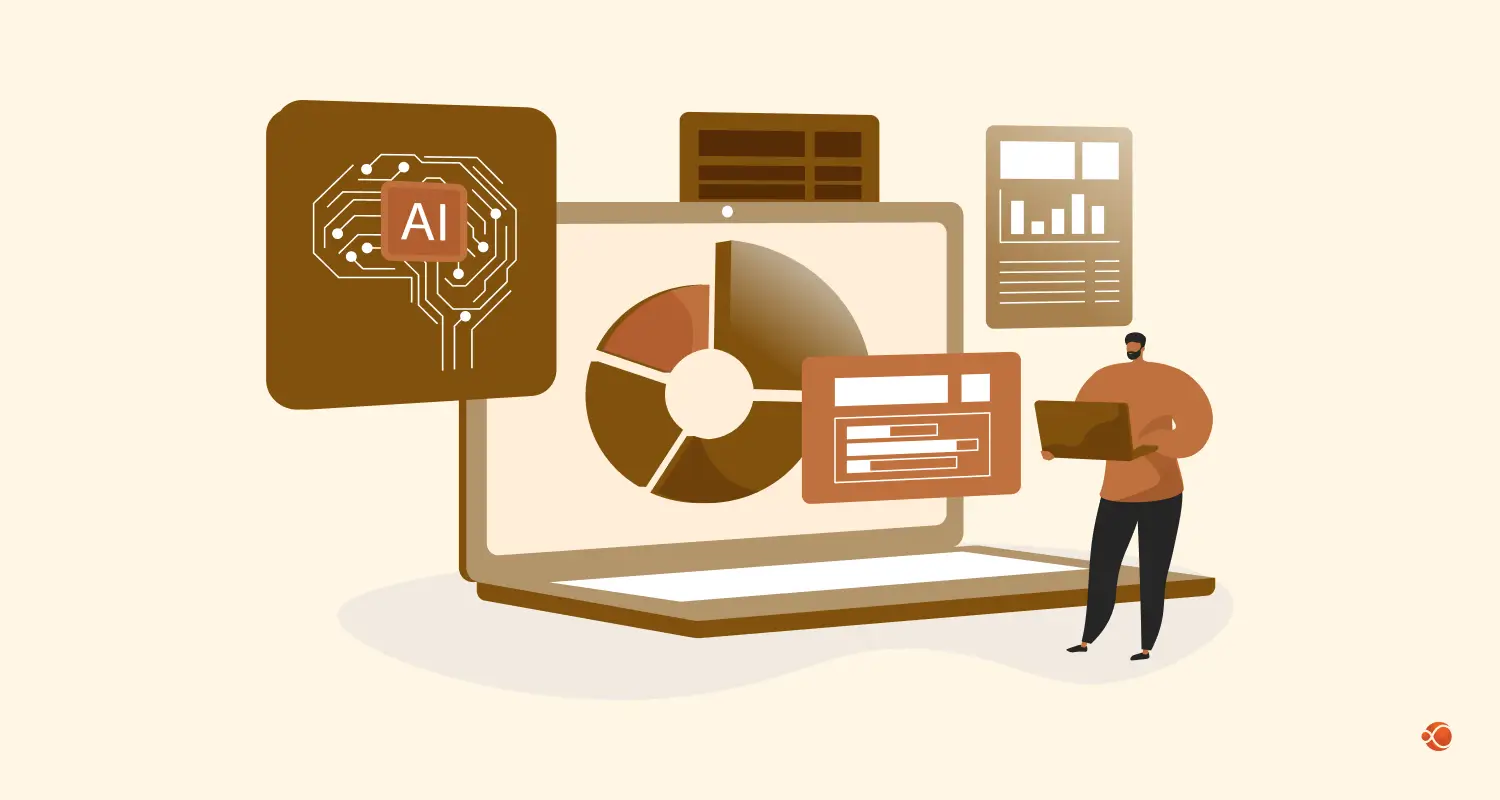Quick Summary: Explore the different types of AI: ANI, AGI, and ASI, to understand their impact today and potential tomorrow. This blog explains how each type shapes industries and why staying informed is essential for future-ready businesses.
Artificial Intelligence has evolved from a new, emerging concept to become our daily companion, with faster adoption rates for any technology since the introduction of PCs and the internet. The AI market has been democratized, where it is no longer restricted to research labs or tech giants; anyone can access it through popular LLM platforms like ChatGPT, Gemini, and others.
But AI is not a single thing. It is a much broader concept, and we are barely at the surface. There are different types of AI, broadly categorized into three categories: ANI (Artificial Narrow Intelligence), AGI (Artificial General Intelligence), and ASI (Artificial Superintelligence).
Understanding these differences can help us see where we are today in terms of exploring AI, where we are heading, and what the future might hold. Today, we will get a deeper understanding of these concepts through the viewpoints of experts such as Geoffrey Hinton, Sam Altman, Demis Hassabis, and others who are shaping our understanding of ANI, AGI, and ASI.
The Different Types of Artificial Intelligence: ANI, AGI, and ASI
Before we delve deeper into the comparison between ANI, AGI, and ASI, let’s establish a clear understanding of their core concepts. The classification of different types of AI is not only academically relevant but also useful for businesses, developers, and policymakers to understand what AI can realistically achieve today, versus what remains speculative.
Different Types of AI: What is ANI in AI?
ANI is also known as Weak AI, and it refers to all the systems designed to perform a single task to the best of their capabilities. Consider all the intelligent chatbots, recommendation engines, voice assistants, and even image recognition software; they are all part of ANI. They are called “Weak AI” not because they aren’t good at what they do, but rather because they are designed to be extremely powerful for their niche and lack the ability to generalize beyond their training. The global AI market in 2025 is estimated at USD 757.58 billion, projected to reach USD 3.68 trillion by 2034.

Examples of ANI in daily life:
- Virtual assistants like Gemini, Siri, and Alexa utilize ANI to understand commands and help with everyday tasks.
- Recommendation engines on platforms like Netflix, Amazon, and Spotify that suggest movies, products, or music depending on users’ preferences.
- Spam filters in email services automatically detect and block unwanted or malicious messages.
- Image recognition in apps like Google Photos helps organize and categorize pictures with impressive accuracy.
- Chatbots, such as ChatGPT, when configured for predefined tasks, provide quick responses and automate basic interactions.
Expert Viewpoint of ANI:
Geoffrey Hinton and Andrew Ng are both pioneers of deep learning. They emphasize that ANI has driven most real-world breakthroughs. Andrew refers to Narrow AI as “the new electricity”, which highlights the impact Narrow AI has on major industries.
ANI Applications Across Different Industries
| Industry | ANI Use Cases |
| Retail | Recommending products based on browsing and purchase historyOptimizing stock levels by predicting demand trendsAdjusting pricing dynamically according to customer behavior and competitionPersonalizing marketing emails and offers for individual shoppers |
| Finance | Detecting unusual transactions to prevent fraud in real time Assessing creditworthiness for loans or credit cardsHelping manage investment portfolios with predictive analyticsAutomating customer support for routine banking queries |
| Healthcare | Analyzing medical scans to spot abnormalities fasterPredicting the likelihood of diseases based on patient historyMonitoring patient vitals with smart devices for early alertsAssisting in planning treatment strategies using data-driven insights |
| Real Estate | Estimating property values using historical and market dataMatching buyers with suitable properties based on preferenceForecasting trends in housing markets for investment decisionsAutomating rental price suggestions for landlords and agents |
ANI is what businesses should focus on today. Whenever you invest in any AI software development service or AI model fine-tuning services, you are investing in ANI.
Different Types of AI: What is AGI in AI?
AGI or Artificial General Intelligence is also referred to as “Strong AI”. It refers to an intelligence system capable of human-level reasoning and problem-solving across different domains. AGI is not confined to predefined niches like ANI, and is able to adapt to new tasks without needing to hire remote AI developers.
Examples of AGI in daily life:
- An AI that can perform medical diagnosis, then switch to financial analysis, and later write a novel without retraining.
- A system that can learn entirely new tasks on its own, much like a human picking up new skills.
Expert Viewpoint on AGI:
Leading voices, such as Ray Kurzweil and Demis Hassabis (CEO of DeepMind), have expressed their views that AGI could emerge within this century. Kurzweil has gone to great lengths to predict the achievement of AGI by 2045, linking it to his concept of technological singularity.
Potential Future Applications of AGI
- Faster Cures: AGI can process large chunks of medical data, which helps identify new treatments and cures much faster than humans can.
- Smarter Machines: It enables machines to handle unexpected problems independently, such as a self-driving car navigating a storm.
- Solving Big Problems: AGI can examine huge, complex issues like climate change from every angle to discover new solutions we haven’t considered.

Different Types of AI: What is ASI in AI?
ASI stands for Artificial Superintelligence. That’s a form of intelligence that would be better than humans at just about everything: speed of thought, problem-solving, creativity, even understanding emotional complexity. ASI is not yet a thing, but people discuss it as if it could be incredibly powerful. It made us wonder how we might control it, establish rules for it, and use it safely.
Expert Viewpoint on ASI:
Philosopher Nick Bostrom has written a highly influential book, Superintelligence, which argues that ASI could reshape civilization, either towards unprecedented growth or catastrophic collapse. Another AI expert, Margaret Mitchell (AI ethics leader at Hugging Face), warns that most discussions of ASI often blur the lines between speculation, urging us to ground the conversation in present-day challenges and fairness in AI systems.
Potential Applications of ASI:
- Scientific exploration: ASI could make discoveries in science that people are not able to.
- Decision-making: It can tackle difficult problems in areas such as government or the economy.
- New technologies: ASI might invent things that exceed the human mindset of what’s possible.
Although ASI remains theoretical, it highlights why ethical guardrails must be part of the conversation now.
3 Types of Artificial Intelligence: A Comparative Overview of ANI, AGI, and ASI
| Type | Definition | Current Status | Example Applications | Key Thought Leader Perspectives |
| ANI | Narrow, task-specific AI | Fully deployed today | Voice assistants, fraud detection, chatbots | Hinton & Ng: Driving real-world impact |
| AGI | Human-level general reasoning | Not achieved yet | Hypothetical applications in research and robotics | Hassabis: possible by 2030; Altman: transformative yet risky |
| ASI | Beyond-human intelligence | Speculative future | None in practice | Bostrom: existential risk; Mitchell: hype vs. reality |
Expert Viewpoints on the Different Types of AI

Now that we have a better understanding of the different types of AI, let’s examine what some of the industry’s sharpest minds have to say about ANI, AGI, and ASI.
Geoffrey Hinton: The Godfather of Deep Learning
Hinton’s breakthroughs in neural networks made ANI systems, such as speech recognition and image classification, practical. He stresses that while ANI is remarkable, it should not be considered to be similar to human-like thinking. His recent decision to step back from Google to speak openly about AI risks reflects his concern over unchecked advances in AGI.
Andrew Ng: AI as the New Electricity
Ng focuses on reminding businesses to stay focused on the capabilities of ANI today rather than speculating about AGI or ASI. For him, the real opportunity lies in applying narrow AI through professional artificial intelligence consulting services, which brings measurable ROI across various industries.
Demis Hassabis: Building Towards AGI
Hassabis leads Google DeepMind’s effort towards creating general-purpose learning systems. He believes the core stepping stones towards AGI are multi-modal systems and reinforcement learning. He has an optimistic vision and sees AGI as a tool to solve humanity’s toughest problems, from climate change to healthcare.
Sam Altman: The AGI Risk Manager
As OpenAI’s CEO, Sam Altman often strikes a cautious tone when it comes to artificial general intelligence (AGI). To him, it feels both inevitable and potentially dangerous. Reflecting on OpenAI’s journey, he frequently emphasizes the need to strike a balance between innovation and strong AI governance.
Nick Bostrom: The Superintelligence Alarm Bell
Philosopher Nick Bostrom is best known for ringing the alarm on artificial superintelligence (ASI) in his book Superintelligence. He argues that once machines surpass human intelligence, it would be a matter of time before we lose control over making critical decision-making systems. His work influences global AI policy discussions, reframing the AI vs AGI vs ASI debate beyond technical considerations.
Margaret Mitchell: Grounding the Hype
Known for her research on algorithmic bias and fairness, Margaret believes we should not waste energy and resources on AGI and ASI. She believes that discussions about hypothetical superintelligence often overshadow the real and pressing problems with today’s AI systems, such as bias, accountability, and fairness. Her perspective serves as a reminder that ambition in AI should always be grounded in ethics and responsibility, especially for companies developing tools such as prompt engineering or fine-tuning services.
Why Business Leaders Should Understand ANI, AGI, and ASI
At first, the entire discussion of ANI, AGI, and ASI seems very academic; however, in practice, being a C-level executive, an entrepreneur, or CEO of any-sized company, understanding the types of AI technology matters for various reasons:
- Strategic investment: Businesses must recognize that real ROI lies in ANI, not speculative AGI or ASI.
- Talent planning: When you hire remote AI developers, their focus will be on building specialized solutions, not general intelligence.
- Risk management: Governance frameworks must prepare for AGI conversations, even if they are not immediate.
- Innovation roadmap: Emerging fields, such as the Enterprise AI Agents implementation framework, rely on advancing ANI with modular intelligence.
The Role of AI Ecosystems in ANI vs AGI
The AI Ecosystem is evolving around ANI maturity. From AI programming languages like Python and Julia to enterprise-friendly tools, most progress is driven by the use of narrow AI in specific applications. However, companies like DeepMind and OpenAI are experimenting with architectures that could bridge the gap between ANI and AGI.
In this transitional space, organizations can:
- Invest in AI model fine-tuning services to customize ANI solutions.
- Explore AI prompt engineering for generative AI workflows.
- Adopt modular frameworks that allow for scalability when AGI capabilities become a reality.
ANI vs AGI vs ASI: The Real-World Relevance
Here’s the bottom line. Businesses do not need to wait for AGI or ASI to create value. ANI is already reshaping industries. Focusing on building the current AI ecosystem with capabilities of ANI for specific industries and use cases will yield better benefits than speculating about AGI and ASI. However, keep an open mind and keep reading about the progress in AGI and ASI to stay updated about any advancements.
What’s Next: How CMARIX Prepares for the AI Journey Ahead
1. Keep an Eye on Broader AI Research
To stay ahead, we must actively monitor academic papers and leading research labs. This will help us identify new opportunities and understand the next wave of AI capabilities before they become mainstream.
2. Strengthen Ethical AI Use
We make sure that we build and use AI-driven software solutions in an ethical and responsible manner. Our team develops and iterates on proper AI ethical frameworks to mitigate biases.
3. Invest in AI Skills for Your Team
Your dedicated AI team is your greatest asset. All our skilled AI developers, from engineers to managers, develop the skills needed to effectively use AI tools for carrying out your project with utmost efficiency.
4. Explore Flexible AI Systems
At CMARIX, we ensure that we build flexible and modular AI architectures to match the evolving needs of your AI demands as your project scales. This approach allows us to easily integrate new technologies and adapt quickly as the AI landscape evolves.
5. Engage with the AI Community
Building connections with the wider AI community is key to our growth. By participating in forums and conferences, we can gain new insights, share knowledge, and discover potential partnerships.
Final Words
There are 3 types of AI: ANI, AGI, and ASI. ANI has a significant effect on the business landscape today. AGI is a great topic for researchers and debating on what’s possible or what’s next. ASI, on the other hand, raises big philosophical questions about the future of humanity and the balance between AI capabilities and governance.
For enterprises, the path forward is clear. Invest in ANI-driven solutions with a responsible, future-ready mindset. Teaming up with an experienced team for use cases such as AI model fine-tuning services, or Enterprise AI agents implementation framework can help align today’s value creation with tomorrow’s readiness.
FAQs on Different Types of AI: ANI vs AGI vs ASI
How are ANI, AGI, and ASI Different From Each Other?
ANI specializes in specific tasks and is widely used today. AGI would match human-level intelligence and adapt across domains. ASI is a theoretical form of intelligence far beyond human capabilities in every way.
What Is the Difference Between Artificial General Intelligence (AGI) and Artificial Superintelligence (ASI)?
AGI is considered to be on equivalent terms to a human brain. It is capable of learning and reasoning like a human for multiple tasks. ASI can surpass human intelligence in creativity, problem-solving, and decision-making. There is considerable development in AGI, while ASI remains purely hypothetical.
Which Industries Currently Benefit From ANI?
Retail, finance, healthcare, and real estate are major beneficiaries. ANI powers recommendation engines, fraud detection, medical diagnostics, and property analysis. Essentially, any industry that uses task-specific automation sees gains.
Is AGI the Same as the AI We Use Today?
No. Today’s AI is ANI, focused on narrow, specialized tasks. AGI will be able to understand the task at hand, learn, and perform any intellectual task like a human, which we have not yet achieved.







